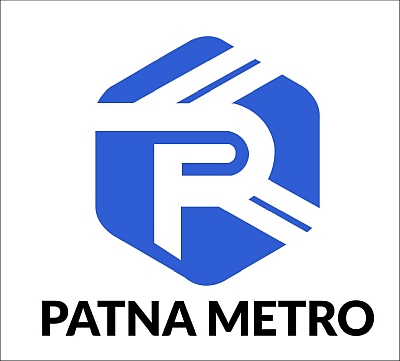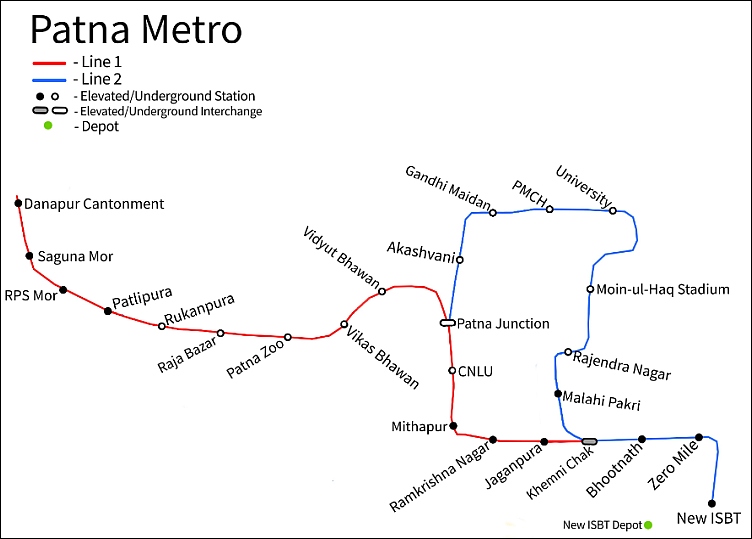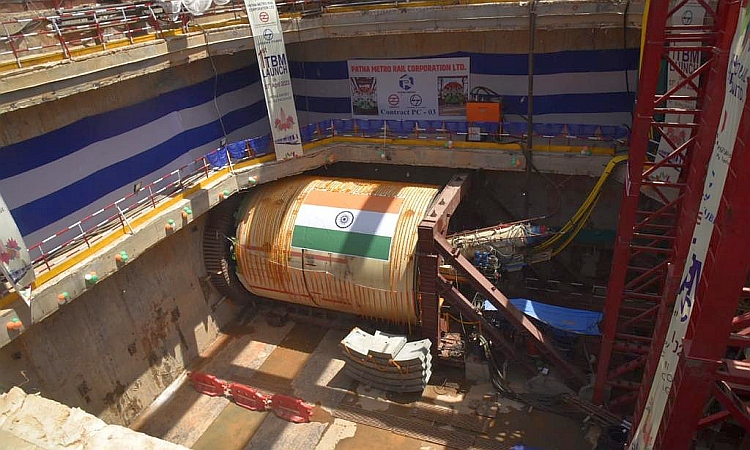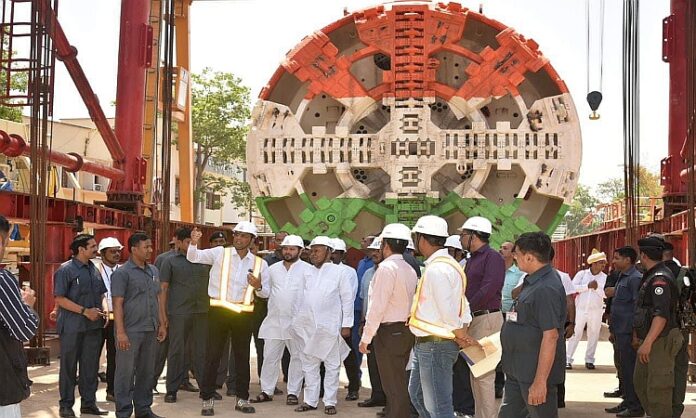Patna: Prompted by the stiff deadline to operationalise the Patna metro rail project by 2026-27, the Delhi Metro Rail Corporation (DMRC) has launched the 2nd tunnel boring machine (TBM) on Friday to speed up construction of underground tunnel. Bihar’s chief minister Nitish Kumar formally launched operation of the TBM near Moinul Haque stadium to build the tunnel up to Malahi Pakri.
The stretch between Moinul Haque stadium and Mahalai Pakri, which is part of corridor-1 of the Patna metro, is being constructed underground. The metro network will surface on the ground after Malahi Pakri and join the 2nd inter-change at Khemni Chak, being built on elevated structure. Another TBM has been launched in September last year, which would build underground tunnel between Moinul Haque stadium to Patna University. The Patna university will be connected to Gandhi Maidan through tunnel, which will further proceed to Patna Junction interchange.
Also Read: 6 Namma metro stations’ names changed ahead launch of new line
Work on the elevated section of corridor-I has also started from Danapur. However, officials said, the work to build tunnel from Patliputra to CNLU via Patna junction inter-change is yet to commence. The process to select the construction company for this stretch is on. Officials said that at least three-four more TBMs would be launched to build the underground network. “Certain modifications in design of underground channel will also be done to allow construction of underground tunnel between Patna Museum and Bihar Museum.
CM launches logo of Patna metro rail

The chief minister along with deputy chief minister Tejashwi Prasad Yadav also launched the logo of Patna metro after formally launching the TBM at Moinul Haque stadium site. The logo has been selected through competition. Many artists had sent their logo designs.
Background
The state urban development department, which is executing the project has appointed the Delhi Metro Rail Corporation (DMRC) as technical consultant to build the 32.50km long network of Patna metro, built in two corridors, in the first phase at the cost of ₹13,411 crore.
While inquiring about progress, the CM told the officials to expedite work on the metro rail project so that people of Patna would have a convenient mass transit system at the earliest. Work on the project is going on in a full-swing. While girders are being laid on some elevated stretches, another TBM is at work to create tunnel in the Gandhi Maidan-University section of the route.
DMRC director (project) Daljeet Singh said that it would take four-five years to operationalise the metro rail, which require a long of other civil and computerised works. “We are doing it faster than the western countries, where the process takes five-six years. We need to work faster to catch up with them (western countries),” said Singh, while briefing about mechanical aspects of the TBM that creates tunnel without disturbing the constructions on the ground.
Network of metro rail
The metro rail network is being built in two corridors, from Danapur to Kheni Chak (19km) and Patna junction to New ISBT (14km), under phase I of the project. Of the total length, 18km strech would be constructed underground while the rest will be on elevated structure.

Officials said that a total of 25 stations have been proposed under phase-I. Twelve stations will be build elevated, while the rest will construction underground. Danapur, Saguna, RPS More and Patliputra stations on corridor-I will be built on elevated structure, while Rukunpura, Rajabazar, Patna Zoo, Vikas Bhawan, Vidyut Bhawan, Patna Junction and CNLU stretch will have underground run. The corridor will resurfaces at Mithapur and terminate at Khenmi Chak interchange.
The 2nd corridor will originate from Patna junction inter-change and lead up to the new ISBT via Akashwani, Gandhi Maidan, PMCH, University, Moinul Haque, Rajendra Nagar, Malahi Pakadi, Kheni Chak, Bhoothnath and Zero Mile.
Metro project approved in 2013
On 11 June 2013, the Bihar cabinet approved the project and appointed RITES to do the feasibility report and prepare detailed project report (DPR) for a metro train service in Patna. In November 2019, DMRC started work on it with minor modifications in its alignment of both lines. The changes led to the creation of a second interchange at Khemni Chowk, the elimination of Line-1’s depot at Aitwarpur, and also the addition of two new stations at Ramkrishna Nagar and Jaganpura.

Project highlights
The PMRC project is getting funds from Centre, State and Japan International Cooperation Agency (JICA). JICA has agree to provide around ₹5,521 crore as long-term loan. The CM made it clear that there would be no shortage of funds for the Patna Metro project. Funds have already been arranged. While the Centre and state would contribute around 30% of the cost, the rest of amount would come from JICA under an agreement reached with the state government.
Additional chief secretary, urban development and housing department, Arunish Chawla said, “The tunnel will be created beneath the water level. One of the TBMs will re-appear near Patna University in five months after building the concrete channel for metro rail. A second tunnel will be constructed from here, which will go through PMCH to Gandhi Maidan.”




